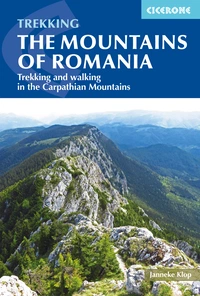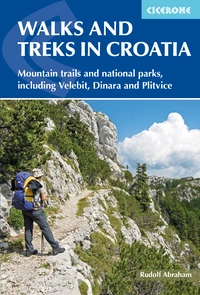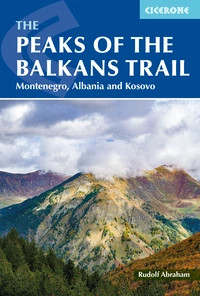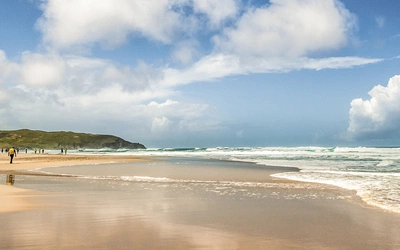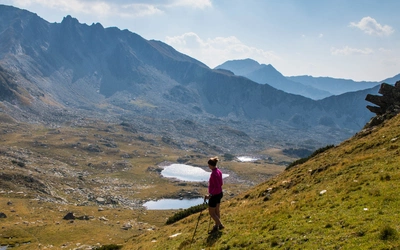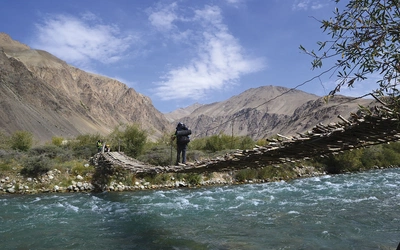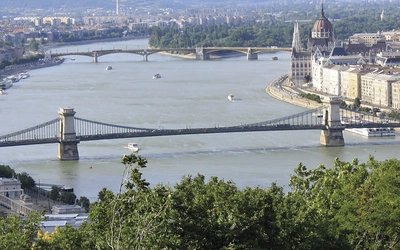The Romanian Mountains: what you need to know
When you think of Romania, you might think of Transylvania and Dracula. But what else do you know about this eastern European country? For one thing, it is roughly the same size as the UK, but it is inhabited by fewer than 20 million people, allowing for nature to take over. It's one of the last wildernesses in Europe and the perfect place to roam wild and free. Here's what you need to know about the Romanian mountains.
The Mountains of Romania
Trekking and walking in the Carpathian Mountains
£18.95
Guidebook to walks and multi-day treks in the Carpathian mountains of Romania. Includes routes in the Maramures and Bucovina regions, Piatra Craiului ridge, and the Retezat and Fagaras mountains.
More informationWhere are the mountains of Romania?
Perhaps you've heard of the Carpathian mountain vampires? The Carpathian mountains in Romania form an imposing arc that covers one-third of Romania’s territory and offers a bewildering array of options for the avid hiker looking for adventure and solitude. Our guidebook offers 37 routes – including popular routes and more remote backpacking routes – with a combined total of 112 stages to explore the stunning area.
Why go hiking in Romania?
The Carpathian mountains are the last true wilderness of Europe. They are home to approximately 65% of Europe’s remaining ancient forests: the habitat of a sizeable population of brown bears and wolves and lynx. Your options are near endless: conquer Romania’s most extended ridge, the Făgăraş, and climb the country’s highest peak, Moldoveanu (2544m); go walking in Transylvania; admire natural rock sculptures in the Bucegi and Ciucaş Mountains; scramble up the steep limestone ridge of the Piatra Craiului or walk up a 500-step staircase to Toacă Peak in the Ceahlău.
If you’d instead explore gently rolling hills and spectacular karstic landscapes, try the Apuseni and Trascău Mountains just south of the vibrant city of Cluj-Napoca, or travel 100 years back in time and explore the villages and mountains of rural Maramureş. You may find you need 10 holidays to do justice to the incredible riches nature has endowed this country with.
How to get there?
Romania has several international airports, the biggest of which are Bucharest Otopeni and Cluj-Napoca, but Sibiu and Timişoara are interesting options as well. Do consider travelling to Romania by train; as of 19 January 2020, there is a night train between Brussels and Vienna, from where you can travel to Cluj via Budapest. The entire train journey would take two days from the UK or Western Europe.
When to go trekking in Romania?
The best time to visit the Romania mountains is from June to September. Most of the snow above 2000m will have melted away by June and won’t reappear until October or November. If you prefer to explore the lower mountains, such as the Apuseni, you could safely go as early as May. Romania has a temperate continental climate with hot summers and long, cold winters that may bring metres of snow to the mountains. Although temperatures can soar into the high 30s in July and August, you may expect pleasant temperatures around 15 degrees Celsius up in the mountains – although it can get quite chilly at night!
What are the accommodation options?
The Romanian Carpathians have an excellent network of mountain huts; the Bucegi and Făgăraş are especially well served. Generally, there are more in the Southern Carpathians than in the North (Maramureş and Bukovina). Many refuges are scattered across the mountains, intended for emergency use only, but in practice, many Romanians use them instead of tents. However, don’t count on them being available if you are unfamiliar with the territory. A bed in a hut – known as a cabana – can be reserved over the phone.
Wild camping is permitted in most of Romania, making it an excellent choice for budget-conscious travellers. You could traverse the Făgăraș Ridge in five or six days, camping along the ridge at altitudes above 2,000 metres. However, if you’re hiking in a national park like Retezat, be aware that wild camping is only allowed in designated areas. Emergency refuges are also available but can be crowded, as they’re widely used for overnight stays. Alternatively, cabins, or cabanas, provide affordable and rustic accommodation and a glimpse into Romanian mountaineering culture.
In cities and the countryside, you can find a wide range of accommodation options: from youth hostels to pensions (pensione in Romanian) in charming Saxon towns such as Braşov and Sibiu to wooden cottages and campsites in the lovely villages, the entire country is dotted with — most of Romania is countryside. Make reservations well in advance during the summer; August tends to be busy.
What about public transport?
Public transport is both affordable and a great way to meet locals, as Romanians are known for their sociability and might strike up a conversation with you. For example, a train journey from Bucharest to Brașov costs around £10. Trains offer a form of slow travel, often moving at a relaxed pace through mountainous terrain, providing breathtaking views of the surrounding landscapes. Buses are another option, though they can be more complex to navigate. Taxis are also very affordable, and hitchhiking is a common practice. Locals typically pay a small fee for a lift, but tourists are unlikely to be charged, though it’s polite to offer. Train and bus timetables are available online, but note that bus schedules can be unreliable, and reservations often require a phone call in Romanian. Read more about travelling by train in Romania here.
What are the highlights?
It’s hard to select Romania’s highlights because so much stands out. Certainly iconic are the 90km-long Făgăraş ridge, the Retezat National Park with its 80 lakes, the Rodna Mountains in Maramureş and the razor-like Piatra Craiului limestone ridge. However, many more lesser-known mountain ranges deserve exploring at least as much, such as the Parâng, the Munţii Maramureşului, the Buila-Vânturariţa and the Călimani.
History lies very much on the surface in Romania: medieval citadels dominate many city centres. Castles and fortified churches speak of an eventful past, as do the ruins of the capital of the Roman province of Dacia in Sarmizegetusa Ulpia Traiana. Romanians are among the most hospitable people in the world; do not be surprised if you get offered a drink, an entire meal or a bed for the night. They’ve also made hitchhiking very easy, and a good network of trains and buses is in place. Bear in mind that things can go slowly in Romania and that you may be in for a surprise or two: things often go differently than planned – but usually, they work out better than you could have anticipated.
What are the best routes in the Romanian Mountains?
| Route title | Duration | Distance | Grade |
|---|---|---|---|
| The Mountains of Maramureş | - | - | - |
| Şetref Pass to Rotunda Pass | 4 days | 60km | Moderate-difficult |
| Breb–Creasta Cocoşului–Neteda Pass | 6hr | 16km | Moderate |
| Groşii Ţibleşului to Arcer, Ţibleş and Bran Peaks | 7hr | 23.5km | Difficult |
| Repedea to Prislop Pass | 4–5 days | 85.5km | Moderate-difficult |
| The Eastern Carpathians | - | - | - |
| The Suhard | 2-3 days | 49km | Moderate |
| The Rarău-Giumalău | 3 days | 46.5km | Easy-moderate |
| The Călimani | 3 days | 51.5km | Easy-moderate |
| Izvorul Muntelui to Durau | 3 days | 22.4km | Moderate |
| Bălan to Lacu Roşu | 3 days | 34km | Easy-moderate |
| The Mountains around Braşov | - | - | - |
| Braşov to Râsnov | 2 days | 24km | Easy-moderate |
| Şapte Scări Gorge and Piatra Mare Peak from Dâmbu Morii | 4hr 40min | 17.5km | Moderate |
| Timişu de Sus to Dâmbu Morii via Tamina Gorge | 5hr | 17km | Moderate |
| A north–south traverse of the Baiului | 6hr 30min | 28km | Moderate |
| Across the Baiului and Grohotiş | 2 days | 36km | Easy-moderate |
| Cheia to Bratocea Pass | 1–2 days | 22km | Moderate |
| Poiana Braşov to Bran | 5 days | 64.5km | Moderate |
| Into the Bucegi from the Prahova Valley | 4 days | 51.5km | Moderate |
| The northern ridge | 4–5 days | 42.5km | Moderate-difficult |
| The southern ridge | 7hr 45min | 17km | Difficult |
| The Făgăraş Mountains | - | - | - |
| Iezer-Păpuşa circuit | 2 days | 29km | Moderate |
| From the Iezer-Păpuşa to the Făgăraş | 3 days | 48.5km | Moderate |
| Traversing the Făgăraş from east to west | 5–6 days | 97.8km | Moderate-difficult |
| From the Olt to the Jiu | - | - | - |
| From Păltiniş to Petroşani | 4–5 days | 67.5km | Easy-moderate |
| Cozia circuit | 1–2 days | 12.5km | Moderate |
| Cheia Village–Buila-Vânturariţa ridge–Băile Olăneşti | 3 days | 53.7km | Moderate-difficult |
| The Retezat Mountains | - | - | - |
| Cârnic to Cabana Gura Zlata via Bucura Lake | 3–4 days | 33km | Moderate-difficult |
| Poiana Pelegii to Cârnic via Bucura Lake | 3 days | 23km | Moderate-difficult |
| From the Vâlcan to the Retezat | 2–3 days | 42km | Moderate |
| Jigora Saddle to Cabana Buta | 4 days | 57km | Moderate |
| The Mountains of Banat | - | - | - |
| Domogled Peak circuit from Băile Herculane | 4hr 40min | 11km | Moderate |
| Poiana cu Peri circuit from Băile Herculane | 5hr 30min | 14.5km | Easy |
| The gorges of the Semenic | 3 days | 84km | Easy-moderate |
| The Apuseni Mountains | - | - | - |
| The gorges of the Trascău | 4 days | 84km | Moderate |
| Poşaga de Jos–Scăriţa Belioara–Runc | 6hr | 25km | Moderate |
| Runc–Scăriţa Belioara–Lunca Largă–Runc | 5hr | 19.5km | Moderate |
| Statiunea Vârtop–Cetăţile Ponorului–Padiş– Pietroasa | 4 days | 54.2km | Easy-moderate |
| Gârda de Sus–Scărişoara ice cave–Padiş–Cabana Vărăşoaia–Stâna de Vale | 4 days | 48km | Easy-moderate |
The Mountains of Romania
Trekking and walking in the Carpathian Mountains
£18.95
Guidebook to walks and multi-day treks in the Carpathian mountains of Romania. Includes routes in the Maramures and Bucovina regions, Piatra Craiului ridge, and the Retezat and Fagaras mountains.
More information
